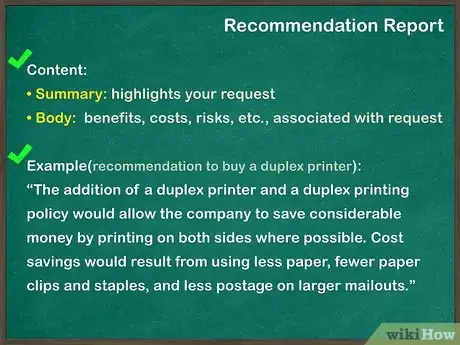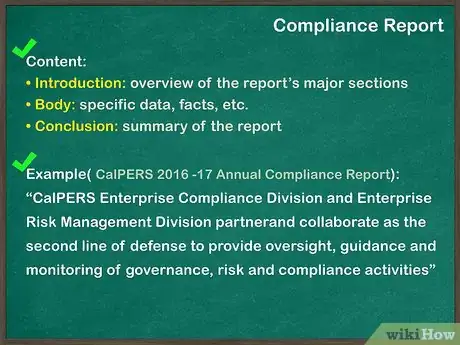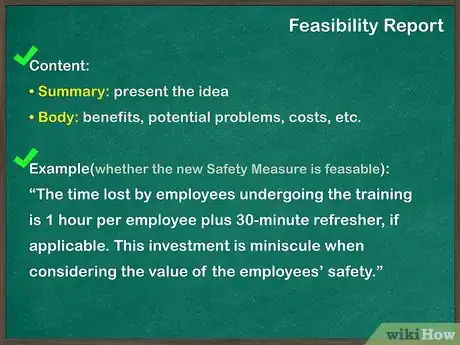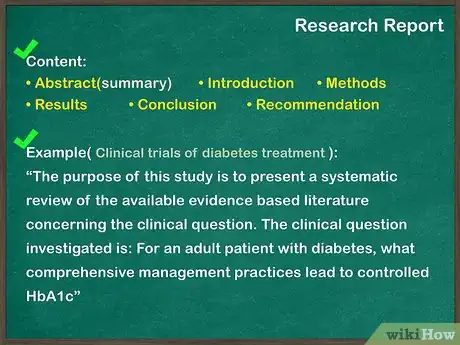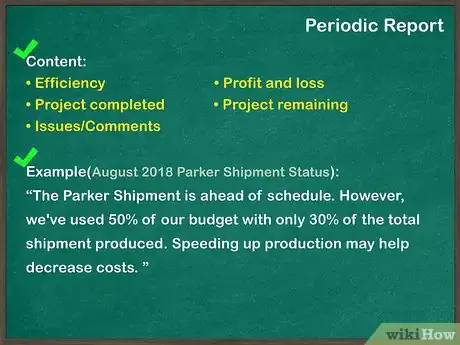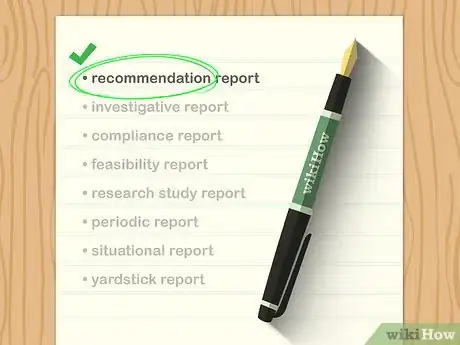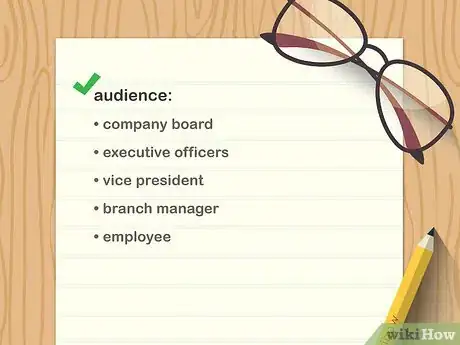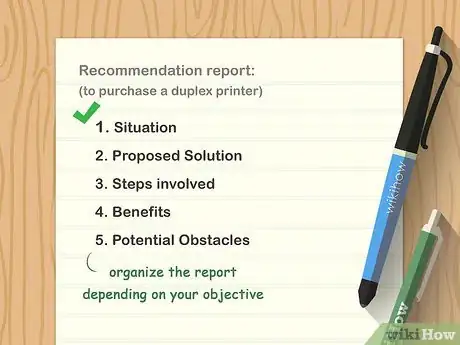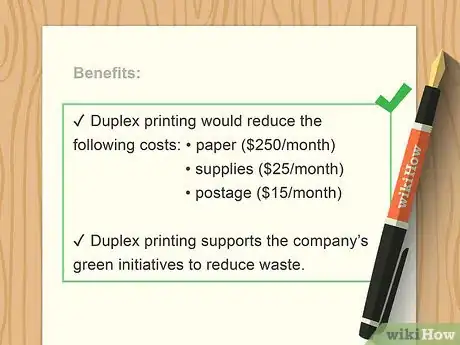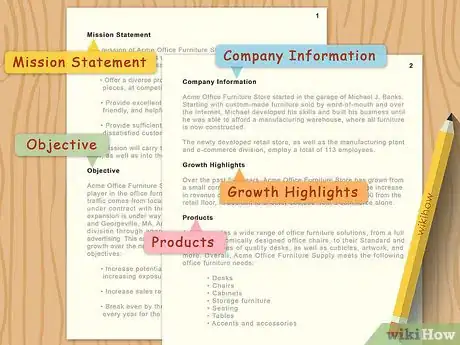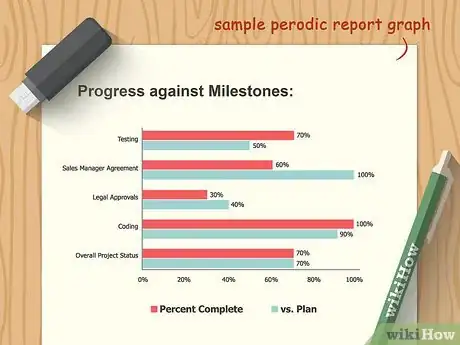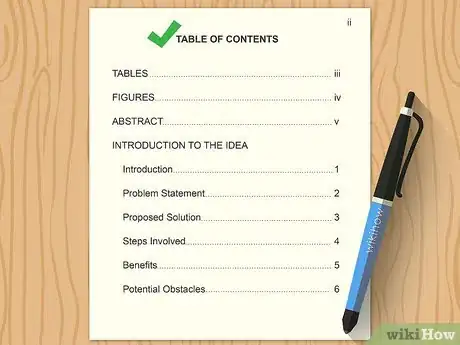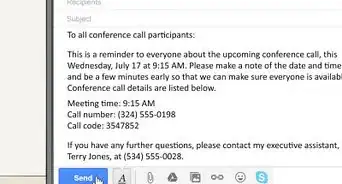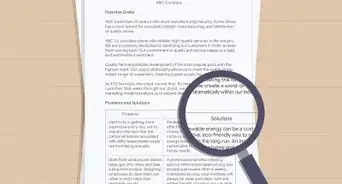This article was co-authored by Michael R. Lewis. Michael R. Lewis is a retired corporate executive, entrepreneur, and investment advisor in Texas. He has over 40 years of experience in business and finance, including as a Vice President for Blue Cross Blue Shield of Texas. He has a BBA in Industrial Management from the University of Texas at Austin.
wikiHow marks an article as reader-approved once it receives enough positive feedback. This article has 12 testimonials from our readers, earning it our reader-approved status.
This article has been viewed 732,347 times.
Business reports are one of the most effective ways to communicate in today’s business world. Although business reports' objectives are broad in scope, businesses or individuals can use them to help make important decisions. To write an effective business report, you first need to understand what it is and how it can be used.
Steps
Deciding What Type of Report to Write
-
1Present an idea. A report that presents an idea is called a justification/recommendation report. You can use these reports to make suggestions to management or other important decision makers. This report typically contains a summary and body. The summary highlights your request. The report’s body delves into the benefits, costs, risks, etc., associated with your request.[1]
- For example, you want a 3D printer for your division. To convince your manager to requisition one, you would write a justification/recommendation report to formally ask the management team for the printer.
-
2Present risks involved with a specific opportunity. An investigative report helps determine the risks involved with a specific course of action. This type of report is great for helping a company anticipate repercussions. The report will contain an introduction, body and conclusion. The introduction highlights the problem under investigation. The body is used to discuss the facts and results of the investigation. The conclusion is used to summarize.[2]
- For instance, say pharmaceutical company X wants to partner with pharmaceutical company Y but has some concerns. Company X doesn’t want to partner with a company that has current financial problems or has had financial problems in the past. Company X conducts an investigation and uses an investigative report to discuss in-depth financial information on company Y and its directors.
Advertisement -
3Present compliance information to a governing body. This report, known as a compliance report, helps companies show accountability. A company will use a compliance report to show proof to a governing body (city, state, federal government, etc.) that it is following all applicable laws/rules and that it is spending money properly. The report contains an introduction, body and conclusion. The introduction typically includes an overview of the report’s major sections. The body contains the specific data, facts, etc., that the regulatory entity needs to know. The conclusion is used to summarize.[3]
- For instance, CALPERS (California Public Employees Retirement System) needed to show its board of administration that it followed all applicable laws and rules in 2010. It put together an annual compliance report to show their activities for the year.
-
4Present the feasibility of an idea or proposed project. An exploratory report to determine whether an idea will work is called a feasibility report. The report should contain a summary and body. The summary presents the idea. The body covers the benefits, potential problems, associated costs, etc., of the proposed idea. A company might use a feasibility report to explore questions such as these:[4]
- Can this project be completed within its budget?
- Will the project be profitable?
- Can this project be completed within the allotted time frame?
-
5Present research found in a study. A research studies report presents research on an issue or problem. It’s an in-depth look at a very specific issue. The report should contain an abstract (summary), introduction, methods, results, conclusion and recommendation. It should also cite the study or studies involved.[5]
- For example, a business might conduct a company-wide study on whether to ban smoking in its employee lounge. The person who writes up the study would produce a research studies report.
-
6Help a company improve its policies, products or processes via consistent monitoring. This report, called a periodic report, is written at fixed intervals, such as weekly, monthly, quarterly, etc. It may examine efficiency, profit and loss, or any other metric over the chosen interval.
- For instance, a pharmaceutical sales representative might provide a monthly summary of his or her sales calls.
-
7Report on a specific situation. A specific situation — as opposed to a fixed interval — calls for a situational report. The situation can be as simple as the information provided at a conference or as complex as a report on the response to a natural disaster. These reports contain an introduction, body and conclusion. Use the introduction to identify the event and briefly preview what you cover in the body of the report. The conclusion discusses the undertaken or necessary actions for the situation.
- As an example, a state’s governing body would like a situational report after a hurricane.
-
8Present several solutions for a problem or situation. A yardstick report weighs several potential solutions for a given situation. Based on the results, the writer would recommend a particular course of action. A yardstick report should contain an introduction, body and conclusion. The introduction states the report’s purpose. The body presents the situation or problem followed by potential solutions/alternatives. The conclusion reveals the best solution or alternative.[6]
- For instance, ABC Auto Manufacturing, Inc., wants to open a plant in Asia. The report might narrow down three country options based on the company’s needs. The report would then conclude which of the three countries is the best location for the new plant.
Writing a Business Report
-
1Determine your objective and format. Ask yourself what you would like the report to accomplish.[7] Based on the desired objective, choose a type of report from the list above.
- Regardless of the answer, you need to make your objective concise. If it is muddled, then your report will only confuse your audience, which risks damaging the report's credibility.
- For instance, you may want to accomplish receiving a larger advertising budget for your department. Your report should focus on the current advertising budget and how you might effectively use a larger budget.
-
2Identify your audience. Your audience may include an outside party (someone who doesn’t work within your company) or someone within your firm. Consider the knowledge or familiarity the audience already has with the intended topic. Also, think about how the audience will use the information in the report.[8]
- Remember that regardless of your audience, no bottom line speaks louder than money to a company or client.
- For instance, say you want to implement a job-share program for your division. You decide your target audience is the company’s HR director, CEO and COO. Consider how much they likely know about job-share programs already. The answer will set the tone for the report. If your company has never considered a job-share program, then the report will be both informational and strategic. If the company has considered a job-share program, then the report will be less informational and more persuasive.
-
3Identify what you need to learn. The hardest part of writing a business report isn't in the writing. It’s forming a conclusion and collecting the data necessary to support that conclusion. This involves a variety of skills, including data collection and market analysis. What do you — and, in the end, management — need to know to make an informed decision about the topic?
-
4Collect the appropriate data for your report. It is important that your data is well-researched; otherwise, you risk losing credibility. Data gathering itself is going to depend on the type of report that you write. Ensure that the data parameters you choose are concise and relevant to the point of the report.[9]
- Data may come internally, which means you'll be able to collect it quite quickly. Sales figures, for example, should be available from the sales department with a phone call, meaning you can receive your data and plug it into your report quickly.
- External data may also be available internally. If a department already performs customer analysis data collection, borrow that department's. You don't need to conduct the research on your own. This will be different for every type of business, but the writer of a business report often doesn't need to conduct firsthand research.
- For instance, if you are writing a justification/recommendation report, then you have to research all the benefits of your proposed idea and incorporate the research into your report.
-
5Organize and write the report. How you organize your report depends on your objective. For instance, you would organize a compliance report differently than a feasibility report. Once you have an idea of how you want to organize your report, you can write your content.
- Break up relevant data into separate sections. A business report can't be a big flood of figures and information. Organizing the data into separate sections is key to the success of a well-written business report. For example, keep sales data separate from customer analysis data, each with its own header.
- Organize the report into appropriate section headers, which may be read through quickly as standalone research, but also supporting the basic objective of the report together.
- Since some of the sections may depend upon analysis or input from others, you can often work on sections separately while waiting for the analysis to be completed.
-
6Draw conclusions with specific recommendations. Draw clear conclusions that follow logically from the data examined in the report. Clearly recommend the best course of action based on those conclusions, if appropriate.[10]
- Any goals should include specific, measurable actions. Write out any changes in job descriptions, schedules or expenses necessary to implement the new plan. Each statement should directly indicate how the new method will help to meet the goal/solution set forth in the report.
-
7Write the executive summary. The executive summary should be the very first page of the report, but it should be the last thing that you write. The executive summary should present your findings and conclusions and give a very brief overview of what someone would read, should they choose to continue reading the entire report. It's like a trailer for a movie, or an abstract in an academic paper.[11]
- The executive summary gets its name because it's likely the only thing a busy executive would read. Tell your boss everything important here, in no more than 200-300 words. The rest of the report can be perused if the boss is more curious.
-
8Use infographics for applicable data, if necessary. In some cases, you may find it helpful to include graphs or charts displaying quantitative data. Use color within the display, as it draws more attention to and helps to differentiate the information. Whenever possible, use bullet points, numbers or boxed data to help with readability. This sets your data apart from the rest of your report and helps to indicate its significance.
- Generally speaking, visual figures are a great idea for business reports because the writing and the data itself can be a little dry. Don’t go overboard, though. All infographics should be relevant and necessary.
- Use boxes on pages with a lot of text and no tables or figures. A page full of text can be tiresome for a reader. Boxed information can also effectively summarize important points on the page.
-
9Cite your sources, if necessary. Depending on what kind of research you've done, you might need to explain where you obtained your information. The purpose of the bibliography or sources page in a business report is to provide a resource for others should they wish to follow up on the data and look into it.[12]
- Use the appropriate formatting for the citations in your report, based on your industry.
-
10Proofread your report twice. Misspellings or basic grammatical errors may give your readers the impression that you didn’t put enough effort into the report. These errors can even call into question the credibility of your findings. Also, make sure that you present your information in a clear, concise way.[13]
- For example, don’t overuse fancy words or make your sentences too wordy.
- Avoid using slang.
- If your report and audience are both closely tied to a specific industry, it's appropriate to use jargon or technical terms. But you have to take care to not overuse jargon and technical terms.
- Generally, business writing is written in the passive voice, and this is one of the few instances where passive writing is usually better than active writing.
- You can often miss errors while proofreading your own work due to the familiarity from writing it. Consider asking someone else in your department who wants the report to succeed to read over it as well. Be open to the feedback. It's better to hear about mistakes from a co-worker than from a boss. Review each comment from the peer review and rewrite the report, taking comments into consideration.
-
11Create a table of contents. Format the business report as formally as possible, creating a table of contents to make it easy to reference and flip through your report. Include all relevant sections, especially the executive summary and conclusions.
-
12Package your business report. The best complement to a thorough, well-researched report is polished packaging. This may include nice folders, binders or paper. The bottom line is that your business report needs to look sharp to intrigue your audience enough to read it.
- This applies to any graphs or charts included in the report as well.
Expert Q&A
Did you know you can get expert answers for this article?
Unlock expert answers by supporting wikiHow
-
QuestionShould we sign at the end of the report?
 Michael R. LewisMichael R. Lewis is a retired corporate executive, entrepreneur, and investment advisor in Texas. He has over 40 years of experience in business and finance, including as a Vice President for Blue Cross Blue Shield of Texas. He has a BBA in Industrial Management from the University of Texas at Austin.
Michael R. LewisMichael R. Lewis is a retired corporate executive, entrepreneur, and investment advisor in Texas. He has over 40 years of experience in business and finance, including as a Vice President for Blue Cross Blue Shield of Texas. He has a BBA in Industrial Management from the University of Texas at Austin.
Business Advisor Signatures typically appear on a cover letter transmitting the report, rather than the report itself. However, the names of those who collected and analyzed data or made recommendations (and their titles and qualifications, if not known) should be included on the Title Page between the Report Title and the Date of the Report.
Signatures typically appear on a cover letter transmitting the report, rather than the report itself. However, the names of those who collected and analyzed data or made recommendations (and their titles and qualifications, if not known) should be included on the Title Page between the Report Title and the Date of the Report. -
QuestionHow to write a short report on my business breakdown for the month?
 Michael R. LewisMichael R. Lewis is a retired corporate executive, entrepreneur, and investment advisor in Texas. He has over 40 years of experience in business and finance, including as a Vice President for Blue Cross Blue Shield of Texas. He has a BBA in Industrial Management from the University of Texas at Austin.
Michael R. LewisMichael R. Lewis is a retired corporate executive, entrepreneur, and investment advisor in Texas. He has over 40 years of experience in business and finance, including as a Vice President for Blue Cross Blue Shield of Texas. He has a BBA in Industrial Management from the University of Texas at Austin.
Business Advisor Review the steps in wikiHow's How to Write a Progress Report for a good primer on report writing.
Review the steps in wikiHow's How to Write a Progress Report for a good primer on report writing.
References
- ↑ https://www.indeed.com/career-advice/career-development/formal-business-report-example
- ↑ https://www.indeed.com/career-advice/career-development/formal-business-report-example
- ↑ https://www.indeed.com/career-advice/career-development/formal-business-report-example
- ↑ https://openoregon.pressbooks.pub/lbcctechwriting/chapter/7-7-feasibility-reports/
- ↑ https://www.adelaide.edu.au/writingcentre/ua/media/44/learningguide-businessreportwriting.pdf
- ↑ https://www.wgtn.ac.nz/learning-teaching/support/approach/steps-to-teaching-success/resources/WSBG-report-writing-guide-2017.pdf
- ↑ http://wac.colostate.edu/teaching/tipsheets/writing_business_reports.pdf
- ↑ http://wac.colostate.edu/teaching/tipsheets/writing_business_reports.pdf
- ↑ https://www.unr.edu/writing-speaking-center/student-resources/writing-speaking-resources/how-to-write-a-business-report
- ↑ https://www.unr.edu/writing-speaking-center/student-resources/writing-speaking-resources/how-to-write-a-business-report
- ↑ https://www.wgtn.ac.nz/learning-teaching/support/approach/steps-to-teaching-success/resources/WSBG-report-writing-guide-2017.pdf
- ↑ https://www.unr.edu/writing-speaking-center/student-resources/writing-speaking-resources/how-to-write-a-business-report
- ↑ https://www.wgtn.ac.nz/learning-teaching/support/approach/steps-to-teaching-success/resources/WSBG-report-writing-guide-2017.pdf
About This Article
To write a business report, start with an introduction that presents a clear idea, problem, or objective. Next, present the facts, focusing on one main idea per paragraph, and discuss benefits and possible risks associated with your objective. Then, present your research and proposed solutions. Be sure to organize the data into separate sections based on subject matter and include section headers for readability. Finally, summarize the main points of your report in the conclusion. For tips on formatting different kinds of business reports, read on!
